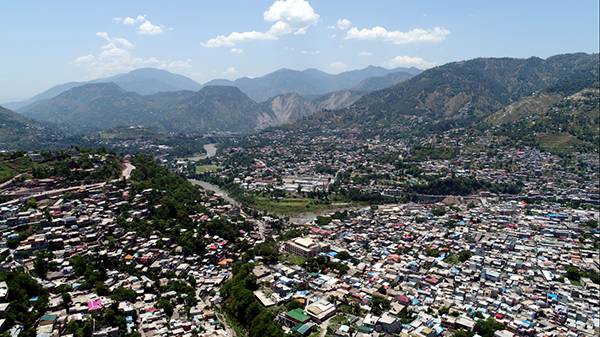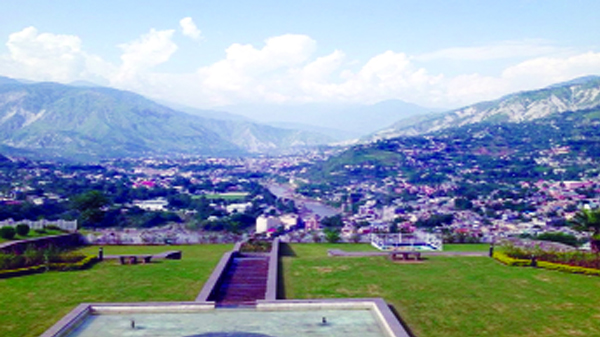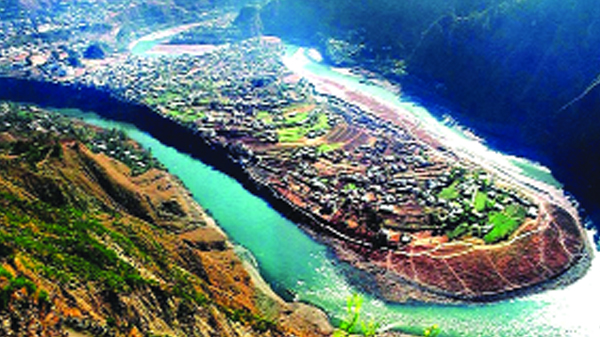
I always consider two options whenever I am returning to Muzaffarabad – capital city of Azad Jammu and Kashmir and my hometown. In case I am to arrive in the city at night; I prefer to travel via the Abbotabad-Mansehra road. If, on the other hand, I am due to arrive in the light of day, my preferred route of travel is the Muree-Kohalla route.
Why so?
To see the inverted cup full of what appear to be shining stars in the night. As you take the sharp turn from Lohar Galli, the main entrance to the city, you realise that these ‘stars’ are in fact the lights of houses on the mountains that encircle the whole city. And to run opposite to the mixing waters of three rivers: Neelum, Jhelum and Kunhar, while enjoying the cooling breeze from Murree till Kohalla.
Neelum, a river which flows through the heart of the beautiful valley of the same name, joins Jhelum, coming from the Jhelum Valley, at Domail – the heart of Muzaffarabad city. And it looks as if both rivers are holding each other in their arms. That charming junction point is known as Sangum.
Both rivers go on to include Kunhar in their embrace– the river flowing in from neighbouring Khyber-Pakhtunkhwa province, at Domishi, outside Muzaffarabad city. All the three flow together till Kohalla – which is the point at which they bid farewell to Kashmir.

Muzaffarabad city, located on the bank of these rivers is the gateway to the Neelum Valley, has witnessed several decades of border tensions between Pakistani and Indian forces deployed at the Line of Control (LoC). Now, despite all this, due to its immense scenic beauty it is the ultimate choice for domestic and international tourists looking to explore the broader region.
The city is in a phase of rebirth after witnessing that horrible day of the 8th of October 2005, when a horrific earthquake struck the region. At that time, the whole infrastructure was completely wrecked, presenting the look of a burial ground or a maze of collapsed buildings. Today, one would have to observe very minute details indeed, if they are looking for visible reminders of the 2005 earthquake. However, graveyards in the city will tell the whole story.
The major portion of the population lived in the outskirts of the city before the tragedy. The destruction caused them to move inside – and at present one could say that the city is overcrowded.
Muzaffarabad can appear similar to Rawalpindi – not in size and population, of course, but with the mix of various cultures created by people who settled here. Most of them are employees, serving different governmental institutions. Or they are employees of financial institutions like banks – which are the main private-sector employers.

In a 45-minute drive from Kohalla to Muzaffarabad city, one can feast their eyes on the blue water flowing alongside the road to the left. Here you pass also the Quaid-e-Azam Memorial Rest House at Barsla, at a 20-minute drive from Kohalla. Pakistan’s founder stayed here during his first visit to Muzaffarabad in 1944. The traveler would note also the Cadet College building at Chatter Kallas, the construction work on King Abdullah University Muzaffarabad and a few construction sites for hydropower mega-projects – including the 1,124 MW Kohalla Hydropower Project (as part of the China Pakistan Economic Corridor) and the 969 MW Neelum Jhelum Hydropower Project.
As you enter the city, passing the New Secretariat area, you come to a series of banks – this area is, predictably, called Bank Square. On the left are the Secretariat, the AJK Legislative Assembly building, the Supreme Court and other government buildings.
Muzaffarabad, like the rest of Kashmir is as a land of sufis and saints. Muzaffarabad hosts the shrines of prominent sufis Saheli Sarkar, Shah Inayat Wali, Shah Hussain Bukhari, Pir Alam Shah Bukhari and many others. Devotees from all parts of the country may be found on any day visiting these shrines located in the centre of the city. Multan and Muzaffarabad are often seen as twin cities because – in the popular imagination – some 100,000 sufis, saints and spiritual healers visited both the cities.
The 2017 census shows Muzaffarabad’s population as being over 6.5 million and with that it becomes the second largest populated city of the state. Kotli with over 7 million people is at number one.
The city enjoys easy access from Islamabad, Abbotabad and other areas. The hotels and guest houses are busy places. Tourists traveling to Pir Chanasi, Neelum and Jhelum valleys prefer a night stay in Muzaffarabad. One can drink in the sight of whole city from the Pearl Continental Hotel in Muzaffarabad.
At present, you only have access to Muzaffarabad by road. The government has been claiming to initiate work on the mega Economic Corridor projects with over 10.5 billion rupees to connect tourists spots in the state through quality roads.
But so far, authorities have failed bring to an operational level the dysfunctional airports at Muzaffarabad and Rawalakot.
The ethnic mix of the city becomes apparent very soon. The traveler will notice the Pakhtun residents prominent in some business sectors, especially those pertaining to hotels and cloth. You see handsome Kashmiri refugee boys driving rickshaws and running other small shops despite their higher education.
The condition of public transport is not entirely satisfactory – but not too bad either.
It is my opinion that in two hours you can have a quick round of the city, even on a rickshaw. In this process, you must stop at Tariqabad Road, come out from your vehicle and see the beautiful landscape of the city from this point. You are in a position to see all the big buildings including the city campus of AJK University, Sheikh Zayed Al Nahyan Hospital, University Ground, a recently constructed massive Eid Gah and many other landmarks.
You can also see the historical Red Fort, located on the western side of the River Neelum in Muzaffarabad. This is an archeological site that reminds us of the deep roots in history of the Kashmir valley. Sadly, it is now on the verge of annihilation due to neglect.
The city is not highly developed. But I think it is a pure, hospitable and fascinating place.
Don’t forget to have a dinner on the bank of the river Neelum. Don’t forget to buy Kulchay to eat. Nowhere in the world can you have Kulchay like those of Muzaffarabad. If you travel with kids, you must visit the Jalalabad Garden – where you can have pink Kashmiri tea as the little ones frolic.
Such are my recommendations for your stay in Muzaffarabad. Do go!
Mubashar Naqvi is a freelance writer based in Muzaffarabad. He tweets at @SMubasharNaqvi
Why so?
To see the inverted cup full of what appear to be shining stars in the night. As you take the sharp turn from Lohar Galli, the main entrance to the city, you realise that these ‘stars’ are in fact the lights of houses on the mountains that encircle the whole city. And to run opposite to the mixing waters of three rivers: Neelum, Jhelum and Kunhar, while enjoying the cooling breeze from Murree till Kohalla.
It is my opinion that in two hours you can have a quick round of the city, even on a rickshaw. In this process, you must stop at Tariqabad Road, come out from your vehicle and see the beautiful landscape of the city from this point
Neelum, a river which flows through the heart of the beautiful valley of the same name, joins Jhelum, coming from the Jhelum Valley, at Domail – the heart of Muzaffarabad city. And it looks as if both rivers are holding each other in their arms. That charming junction point is known as Sangum.
Both rivers go on to include Kunhar in their embrace– the river flowing in from neighbouring Khyber-Pakhtunkhwa province, at Domishi, outside Muzaffarabad city. All the three flow together till Kohalla – which is the point at which they bid farewell to Kashmir.

Muzaffarabad city, located on the bank of these rivers is the gateway to the Neelum Valley, has witnessed several decades of border tensions between Pakistani and Indian forces deployed at the Line of Control (LoC). Now, despite all this, due to its immense scenic beauty it is the ultimate choice for domestic and international tourists looking to explore the broader region.
The city is in a phase of rebirth after witnessing that horrible day of the 8th of October 2005, when a horrific earthquake struck the region. At that time, the whole infrastructure was completely wrecked, presenting the look of a burial ground or a maze of collapsed buildings. Today, one would have to observe very minute details indeed, if they are looking for visible reminders of the 2005 earthquake. However, graveyards in the city will tell the whole story.
The major portion of the population lived in the outskirts of the city before the tragedy. The destruction caused them to move inside – and at present one could say that the city is overcrowded.
Muzaffarabad can appear similar to Rawalpindi – not in size and population, of course, but with the mix of various cultures created by people who settled here. Most of them are employees, serving different governmental institutions. Or they are employees of financial institutions like banks – which are the main private-sector employers.

In a 45-minute drive from Kohalla to Muzaffarabad city, one can feast their eyes on the blue water flowing alongside the road to the left. Here you pass also the Quaid-e-Azam Memorial Rest House at Barsla, at a 20-minute drive from Kohalla. Pakistan’s founder stayed here during his first visit to Muzaffarabad in 1944. The traveler would note also the Cadet College building at Chatter Kallas, the construction work on King Abdullah University Muzaffarabad and a few construction sites for hydropower mega-projects – including the 1,124 MW Kohalla Hydropower Project (as part of the China Pakistan Economic Corridor) and the 969 MW Neelum Jhelum Hydropower Project.
As you enter the city, passing the New Secretariat area, you come to a series of banks – this area is, predictably, called Bank Square. On the left are the Secretariat, the AJK Legislative Assembly building, the Supreme Court and other government buildings.
Muzaffarabad, like the rest of Kashmir is as a land of sufis and saints. Muzaffarabad hosts the shrines of prominent sufis Saheli Sarkar, Shah Inayat Wali, Shah Hussain Bukhari, Pir Alam Shah Bukhari and many others. Devotees from all parts of the country may be found on any day visiting these shrines located in the centre of the city. Multan and Muzaffarabad are often seen as twin cities because – in the popular imagination – some 100,000 sufis, saints and spiritual healers visited both the cities.
The 2017 census shows Muzaffarabad’s population as being over 6.5 million and with that it becomes the second largest populated city of the state. Kotli with over 7 million people is at number one.
The city enjoys easy access from Islamabad, Abbotabad and other areas. The hotels and guest houses are busy places. Tourists traveling to Pir Chanasi, Neelum and Jhelum valleys prefer a night stay in Muzaffarabad. One can drink in the sight of whole city from the Pearl Continental Hotel in Muzaffarabad.
At present, you only have access to Muzaffarabad by road. The government has been claiming to initiate work on the mega Economic Corridor projects with over 10.5 billion rupees to connect tourists spots in the state through quality roads.
But so far, authorities have failed bring to an operational level the dysfunctional airports at Muzaffarabad and Rawalakot.
The ethnic mix of the city becomes apparent very soon. The traveler will notice the Pakhtun residents prominent in some business sectors, especially those pertaining to hotels and cloth. You see handsome Kashmiri refugee boys driving rickshaws and running other small shops despite their higher education.
The condition of public transport is not entirely satisfactory – but not too bad either.
It is my opinion that in two hours you can have a quick round of the city, even on a rickshaw. In this process, you must stop at Tariqabad Road, come out from your vehicle and see the beautiful landscape of the city from this point. You are in a position to see all the big buildings including the city campus of AJK University, Sheikh Zayed Al Nahyan Hospital, University Ground, a recently constructed massive Eid Gah and many other landmarks.
You can also see the historical Red Fort, located on the western side of the River Neelum in Muzaffarabad. This is an archeological site that reminds us of the deep roots in history of the Kashmir valley. Sadly, it is now on the verge of annihilation due to neglect.
The city is not highly developed. But I think it is a pure, hospitable and fascinating place.
Don’t forget to have a dinner on the bank of the river Neelum. Don’t forget to buy Kulchay to eat. Nowhere in the world can you have Kulchay like those of Muzaffarabad. If you travel with kids, you must visit the Jalalabad Garden – where you can have pink Kashmiri tea as the little ones frolic.
Such are my recommendations for your stay in Muzaffarabad. Do go!
Mubashar Naqvi is a freelance writer based in Muzaffarabad. He tweets at @SMubasharNaqvi

